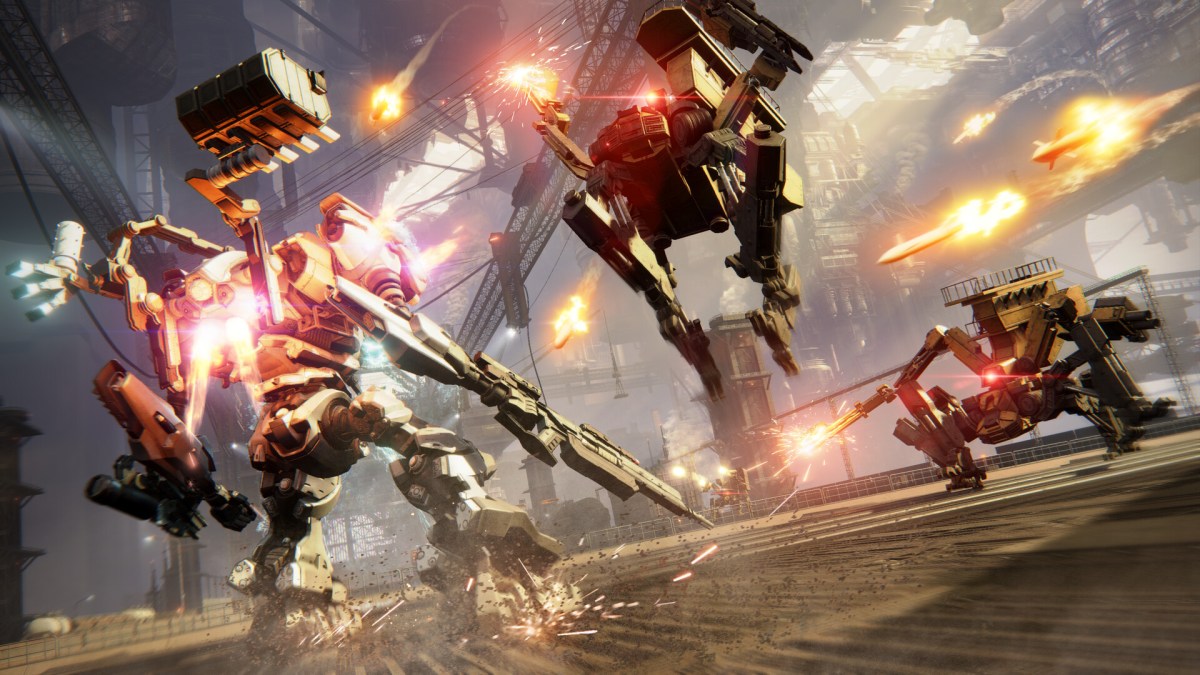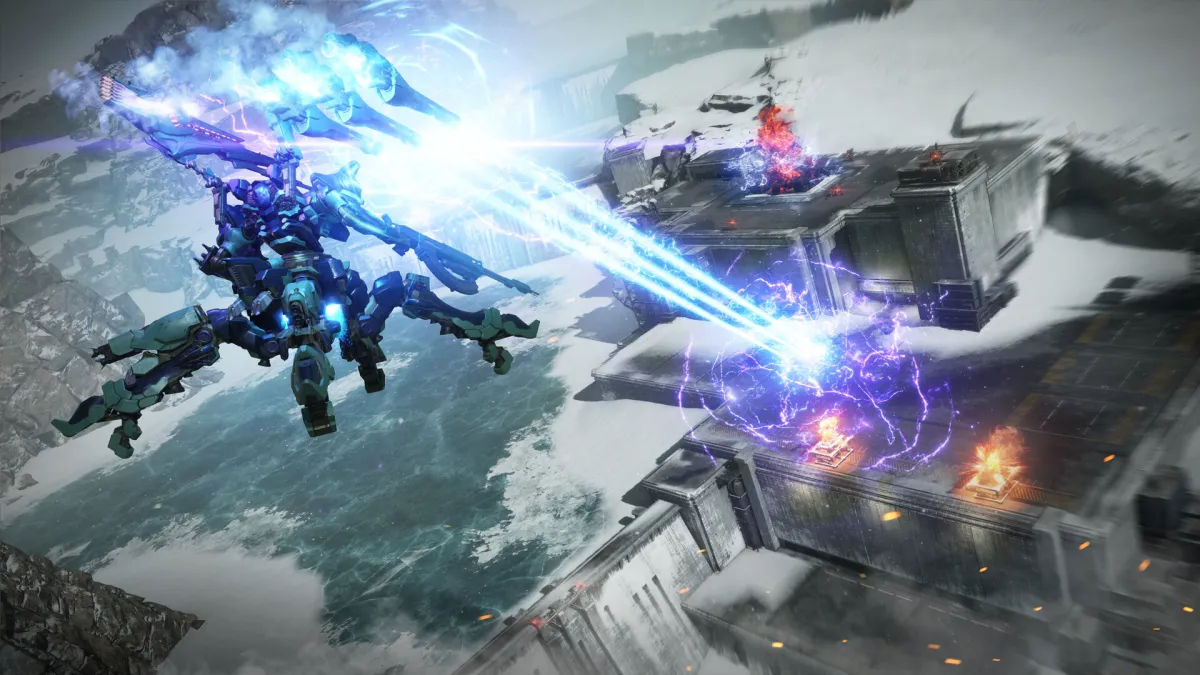Fire ravages a planet far flung at the edge of the universe, roiling over its surface and casting everything in a thick layer of ash. What many would consider to be a desolate hunk of rock, not capable of human life, is the center of conflict in a universe embroiled in an endless war thanks to corporate entities that feed on this perpetual strife. This planet, Rubicon, is where Armored Core VI: Fires of Rubicon is set, and where you assume the role of a mercenary unfit for a callsign. While the game begins with a fair enough amount of exposition to throw you into the thick of things, it serves as a perfect introduction to the series for newcomers, and is almost like a familiar, welcome embrace for those returning to the long dormant series. But what it is above all else is a triumphant show of finesse for FromSoftware in more ways than one.
You hit the ground running and begin your first mission, a general tutorial on the hunt for the remains of a Core, to take the identity of its dead pilot. After shooting your way through a dilapidated tower and defeating an extremely well-armed helicopter, you find what you’re looking and assume the role of Raven. Though while the world at large may call you Raven, Handler Walter continues to refer to you as 621. It is the callsign you bore at the beginning of the game, when you were nothing but nameless hunk of flesh strapped into your first Armored Core.
This is who you remain at your core, regardless of what faction you choose to side with, giving the player some illusion of autonomy in the struggle for Rubicon. Because while you can ultimately decide the fate of the planet as it is effectively torn to pieces and mined for Coral, an invaluable resource to the dominating military corporations of the universe, you are a mercenary at the end of the day. You’re beholden to your own whims and those of your employer, be they part of the military industrial complex or not. You’re just a cog in the system, ground to dust in the military industrial complex that’s stretched outward into the very depths of space.
What this means for Rubicon is entirely up to you, as Armored Core VI is spread across five chapters. The total length of the game will vary vastly between players, mostly because boss fights can be particularly arduous if you’re like me and refuse to adapt to the way Armored Core VI wants to be played.

Each chapter consists of more than a handful of missions. Missions can last anywhere from a handful of minutes to potentially hours, depending how effective you are at them, and are constrained to small individual zones. Armored Core VI doesn’t boast an open world and is probably better for it. Some missions require you to take out enemy Armored Cores or deal with turrets that prevent the faction you are currently aligned with from strengthening their individual hold on Rubicon. These missions, while sometimes challenging, make you feel especially powerful. I tore my way through swaths of enemies to locate my objective with HI-32: BU-TT/A Pulse Blade — which I feel is the best weapon in the game due to its high stagger damage and general output. Others are boss fights that will no doubt test any seasoned FromSoftware veteran and those unfamiliar with the rhythmic combat of Sekiro or aggressive playstyle of Bloodborne. Both of those games are my favorite FromSoftware titles, and I still struggled even until the later hours of my playthrough.
I will say that Armored Core VI left my hands hurting after some fights, and I did need to put my controller down to take breaks. Despite this, the game still felt fair, even during its most trying moments. I understood why I was dying, even if my resources were relatively limited in terms of healing (which can be upgraded, but only to some degree). Armored Core VI always gave me the options to change my weapons and modify my Armored Core before missions or before checkpoints if I had died. Additionally, you can sell parts for the same price you purchased them, which means less grinding to acquire new parts of your Core or even Arms, which is in-universe slang for your weapons. So you can experiment at a whim, with little to no repercussions, as the game wants you to play around with different builds. At times, it even demands it. Especially since Armored Core VI has three different types of damage you can experiment with through various Arms, with some more effective than others. There is one constant players should keep in mind, however, and that’s stagger damage. Fights are a delicate balance between dealing damage and building your enemies stagger bar, and managing your own alongside your stamina.
Since fights take place in a 3D environment, with you able to boost in the air, combat is incredibly dynamic. This is something you’ll need to keep in mind when avoiding attacks that will build your stagger bar, effectively stunning you long enough to possibly kill you in a single hit. Staggering also opens up windows to deal massive damage to enemies, which is what you want to focus your own combos around, be it swiping at them with your pulse blade, shooting a flurry of rockets at them, or using high powered canons.
That said, you can brute force fights. It’s what I did, but left me slamming my head against a proverbial brick wall for upwards of three hours. Specifically, this happened in one fight that happened roughly halfway through, since I was determined to use the pulse blade and shotgun with no shield in combination with a light Frame. This meant I was extremely vulnerable and would die from almost every missile barrage shot my way. But once I was able to find my tempo and got some vague idea of what was killing me — even if it was my own hubris — I was able to overcome the challenge and continue my job as a hand for hire.

In relation to accessibility options, players can fully customize keybinds for keyboard and for controllers. I wasn’t sure if this would be available, but was pleasantly surprised to see that FromSoftware not only allows for multiple control schemes, but also custom ones you can set up yourself. There aren’t any available difficulty modes, however, or even Arms and Frames that potentially make the game easier. This may prove daunting to some who want to get in the robot, or turn them off entirely due to Armored Core VI’s steep difficulty curve that ramps up as early as chapter one.
On the more technical side of things, Armored Core VI’s performance is incredible. I ran the game on a high-end machine touting a 3070Ti, and a gaming laptop with the minimum specs required. Naturally, the game looked phenomenal on the higher-end machine, with each spray of bullets from the muzzle of my rifle punctuated with pops of yellow light, but it looked just as good on my laptop. The UI was a little hard to read, admittedly, though I ended up hooking my laptop up to a 60 inch screen to see how it’d look. Again, I wasn’t disappointed. The game ran perfectly with no frame drops, no lag of any kind, and no screen tearing. The only issue was that it was a bit slow to load at first on my laptop, but after that initial boot it was fine. There were also only one instance of crashing, but that was mostly because my machine is a bit old and my fans have given up the ghost.
It’s hard to find a single thing wrong with Armored Core VI: Fires of Rubicon. Its narrative, while more or less passively told through data logs you can find on missions and spoken at you through your Handler and by those under employ by various corporate and non-corporate factions, is spectacular. It takes a page out of some of the best anti-war sentiments found in the Gundam series, for example. The game isn’t exactly subtle about it either, as resistance members on Rubicon call you a corporate dog and Core pilots from other military organizations hiss insults at you with their dying breath. The music is incredible, and I actually found myself turning down the in-game effects just to hear the hypnotic and sometimes oppressive electronic score. I can’t wait for it to be available through streaming services, just so I can have it on repeat. And the game is gorgeous, even if time spent in areas are relatively limited due to the game’s mission based structure.
Armored Core VI may be the best game FromSoftware has made to date, building upon already solid foundations from Sekiro and Dark Souls and further innovating on the punishing combat the developer is known for. It’s a complete product, with very little hitches in terms of performance even on lower end machines that meet its minimum requirements. With its interesting narrative and anti-war sentiment, it’s a game that I’d recommend to anyone who enjoys the mecha genre or is a die-hard FromSoftware fan.
Armored Core VI: Fires of Rubicon will come to the PS4, PS5, Xbox Series X, Xbox One, and PC on August 25, 2023.